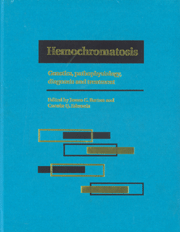Book contents
- Frontmatter
- Contents
- List of contributors
- Foreword
- Part I Introduction to hemochromatosis
- Part II Genetics of hemochromatosis
- Part III Metal absorption and metabolism in hemochromatosis
- Part IV Diagnostic techniques for iron overload
- Part V Complications of iron overload
- Part VI Therapy of hemochromatosis and iron overload
- Part VII Infections and immunity in hemochromatosis
- 35 Role of iron in infections and immunity
- 36 Bacterial infections in hemochromatosis
- 37 Chronic viral hepatitis and hemochromatosis
- 38 T-lymphocyte expression and function in hemochromatosis
- Part VIII Hemochromatosis heterozygotes
- Part IX Relationship of hemochromatosis to other disorders
- Part X Animal models of hemochromatosis and iron overload
- Part XI Screening for hemochromatosis
- Part XII Hemochromatosis: societal and ethical issues
- Part XIII Final issues
- Index
38 - T-lymphocyte expression and function in hemochromatosis
from Part VII - Infections and immunity in hemochromatosis
Published online by Cambridge University Press: 05 August 2011
- Frontmatter
- Contents
- List of contributors
- Foreword
- Part I Introduction to hemochromatosis
- Part II Genetics of hemochromatosis
- Part III Metal absorption and metabolism in hemochromatosis
- Part IV Diagnostic techniques for iron overload
- Part V Complications of iron overload
- Part VI Therapy of hemochromatosis and iron overload
- Part VII Infections and immunity in hemochromatosis
- 35 Role of iron in infections and immunity
- 36 Bacterial infections in hemochromatosis
- 37 Chronic viral hepatitis and hemochromatosis
- 38 T-lymphocyte expression and function in hemochromatosis
- Part VIII Hemochromatosis heterozygotes
- Part IX Relationship of hemochromatosis to other disorders
- Part X Animal models of hemochromatosis and iron overload
- Part XI Screening for hemochromatosis
- Part XII Hemochromatosis: societal and ethical issues
- Part XIII Final issues
- Index
Summary
Introduction
In 1978, it was postulated that the immunological system could have a role in monitoring tissue iron toxicity as part of its surveillance function. Such a function was thought to be expressed in the sequence of cell migration to an inflammatory site: neutrophils, followed by macrophages and lymphocytes. In 1981, the concept was reiterated more extensively and focussed on the question of why there is a circulation of lymphocytes. It has been updated with regularity until 1992. Studies of lymphocyte expression in hemochromatosis strongly supported the initial concept, and were aided by concomitant progress in the development of new tools in immunology and molecular biology that led to the discovery of a new major histocompatibility (MHC) class I gene HFE, the hemochromatosis associated gene. This strengthened the postulate that there is a role of lymphocytes in the regulation of iron load. The central role of macrophages in erythrophagocytosis and iron recycling has long been established. This chapter reviews three main topics: (i) the emergence of the new tools in immunology used in the study of lymphocyte populations in hemochromatosis; (ii) lymphocyte expression and function in hemochromatosis; and (iii) the relevance of the findings in the light of current dogma and of the new evidence. This chapter concludes with a caveat to the clinician, because the ultimate value of experimental evidence must be tested in clinical practice.
New tools in immunology used in the study of hemochromatosis
Monoclonal antibodies
Although the existence of different functional subsets of lymphocytes was suspected for many years, only with the development of the hybridoma technology in 1975 was it possible to produce different monoclonal antibodies (moAbs).
- Type
- Chapter
- Information
- HemochromatosisGenetics, Pathophysiology, Diagnosis and Treatment, pp. 396 - 408Publisher: Cambridge University PressPrint publication year: 2000
- 6
- Cited by



